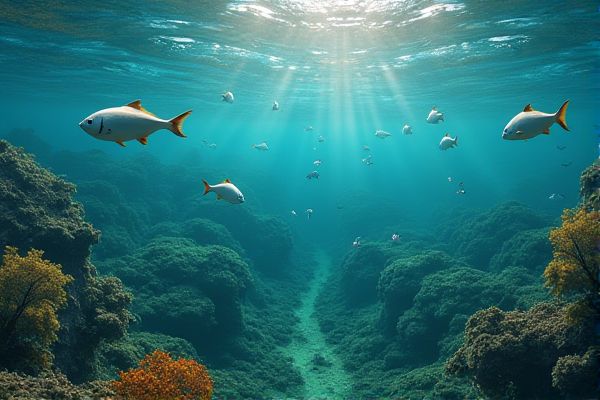
AI applications in aquaculture enhance monitoring and management of fish health and production efficiency. Machine learning algorithms analyze environmental data, such as water quality and temperature, to predict optimal growth conditions. Automated feeding systems utilize AI to adjust feeding schedules based on fish behavior and appetite, reducing waste and improving growth rates. Predictive analytics also help in disease prevention by identifying patterns that signal outbreaks, allowing for timely interventions.
AI usage in aquaculture
Precision Feeding Algorithms
AI usage in aquaculture, particularly through precision feeding algorithms, has the potential to optimize feed utilization and enhance fish growth rates. These algorithms analyze real-time data on fish behavior and environmental conditions to determine the most effective feeding strategies. By implementing such technology, aquaculture operations can reduce waste and lower costs, which is crucial for sustainability. Institutions like the Food and Agriculture Organization (FAO) are exploring these advancements to improve resource efficiency in the industry.
Automated Biomass Estimation
AI usage in aquaculture, particularly for automated biomass estimation, offers significant advantages for monitoring fish populations and optimizing feeding practices. Companies like AquaAI utilize machine learning algorithms to assess biomass more accurately, reducing human error and increasing efficiency. This technology allows farmers to make data-driven decisions that can improve yield and sustainability. The potential for real-time insights presents a compelling opportunity for enhancing operational practices in the aquaculture industry.
Water Quality Monitoring Systems
AI usage in aquaculture can enhance water quality monitoring systems, offering more precise data on parameters such as pH, dissolved oxygen, and temperature. By utilizing machine learning algorithms, these systems can predict harmful conditions and suggest timely interventions for fish health management. For example, institutions like the World Wildlife Fund have explored AI-driven solutions to optimize aquatic environments, leading to improved yield and sustainability. The potential for AI to provide real-time insights presents opportunities for significant advancements in the aquaculture industry.
Disease and Pest Detection Models
AI can significantly enhance disease and pest detection in aquaculture by analyzing large datasets from various sources. Machine learning algorithms can identify patterns in fish health, reducing the risk of outbreaks and improving overall stock management. For example, the use of predictive modeling in institutions like the Aquaculture Research Institute can help farmers make informed decisions. This technological integration presents the possibility of increased efficiency and profitability in aquaculture practices.
Predictive Growth Forecasting
Predictive growth forecasting in aquaculture can enhance fish farming efficiency by analyzing environmental variables and fish health data. AI algorithms can process large datasets to predict optimal feeding schedules and growth rates, potentially increasing yield. Institutions like the Food and Agriculture Organization (FAO) support the integration of AI to improve sustainability in aquaculture practices. This approach may lead to increased economic viability for fish farmers while promoting responsible resource management.
Intelligent Stock Management
AI can enhance stock management in aquaculture by predicting optimal feeding times and quantities, ultimately improving growth rates and resource efficiency. For example, a system like IBM's Watson can analyze environmental data to guide decisions on fish health and feeding schedules. By optimizing these factors, aquaculture operations may reduce costs and increase yields. The implementation of AI technology presents the possibility of higher productivity and sustainability within the industry.
Environmental Impact Analysis
AI applications in aquaculture can enhance productivity through improved monitoring and feeding practices. By analyzing environmental data, tools like remote sensing can pinpoint optimal breeding conditions. Institutions such as the Food and Agriculture Organization are exploring these advancements for sustainable practices. The potential for mitigating environmental impacts while increasing yield offers significant advantages to the industry.
AI-Driven Habitat Optimization
AI-driven habitat optimization in aquaculture can enhance fish growth and health by analyzing environmental parameters such as temperature and oxygen levels. Employing machine learning algorithms may predict optimal feeding strategies tailored to specific species, such as tilapia. This technology can reduce waste and improve resource efficiency, leading to increased profitability for aquafarmers. The potential for real-time monitoring could further allow for timely interventions, minimizing disease outbreaks and promoting sustainable practices.
Energy Efficiency Enhancement
AI can optimize feeding schedules and monitor fish health, which can improve yield in aquaculture operations. By analyzing data from sensors, farms can reduce waste and increase energy efficiency, potentially lowering operational costs. For example, using machine learning algorithms, a facility like a fish hatchery can tailor nutrient delivery based on real-time growth data. This technology opens the door to sustainable practices and enhanced productivity in the aquaculture industry.
Behavioral Monitoring Technologies
AI usage in aquaculture can enhance productivity by optimizing feeding schedules based on fish behavior. Behavioral monitoring technologies, like underwater cameras, enable real-time data collection, allowing for better health management of aquatic species. This integration can potentially reduce costs through improved resource allocation and lower environmental impact. Key institutions, such as research centers focused on marine biology, are exploring these possibilities to drive advancements in sustainable aquaculture practices.
 techknowy.com
techknowy.com